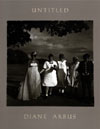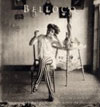Women Photographers
Edited by Constance Sullivan
This book of extraordinary scope and richness showcases the contribution women have made to photography. When you look at their work, I hope you feel as I do—proud to be a woman. Among the 73 artists represented are Lisette Model, Dorothea Lange, Tina Modotti, Helen Levitt, Cindy Sherman, Nan Goldin, Lynne Cohen, Laurie Simmons and Consuelo Kanaga (above, a sample of her work), to name a few. They provide an inspiring reminder to all women that the choice to see, or be seen, is ours. We live in a culture in which this decision is undermined by the notion that the single most valuable contribution a woman can make is to be visually attractive. Women Photographers makes a strong case for seeing and an even stronger case for recording what you see.
Edited by Constance Sullivan
This book of extraordinary scope and richness showcases the contribution women have made to photography. When you look at their work, I hope you feel as I do—proud to be a woman. Among the 73 artists represented are Lisette Model, Dorothea Lange, Tina Modotti, Helen Levitt, Cindy Sherman, Nan Goldin, Lynne Cohen, Laurie Simmons and Consuelo Kanaga (above, a sample of her work), to name a few. They provide an inspiring reminder to all women that the choice to see, or be seen, is ours. We live in a culture in which this decision is undermined by the notion that the single most valuable contribution a woman can make is to be visually attractive. Women Photographers makes a strong case for seeing and an even stronger case for recording what you see.

Untitled
By Diane Arbus
It's simple: every time I look at Diane Arbus's photographs taken at residences for the mentally retarded, I cry. The subjects, mainly women, seem to be bound together on their way to special occasions. They wear costumes over their hospital gowns. They wear masks to hide their faces. They have no artifice, no calculation. The roads these tenuous heartbreakers travel seem to be leading them slowly, surely, and ever so faithfully into that big question mark…the great unknown. Arbus tells us, with the mastery of her vision, that we're not so different from the unfortunate ladies in dress-up, laughing and holding one another as they parade by with the invisible word hope penciled underneath their fake mustaches.
By Diane Arbus
It's simple: every time I look at Diane Arbus's photographs taken at residences for the mentally retarded, I cry. The subjects, mainly women, seem to be bound together on their way to special occasions. They wear costumes over their hospital gowns. They wear masks to hide their faces. They have no artifice, no calculation. The roads these tenuous heartbreakers travel seem to be leading them slowly, surely, and ever so faithfully into that big question mark…the great unknown. Arbus tells us, with the mastery of her vision, that we're not so different from the unfortunate ladies in dress-up, laughing and holding one another as they parade by with the invisible word hope penciled underneath their fake mustaches.

Photographs, Twenty-Five Years
By Keith Carter
I have an old dog named Josie. Last week she had to get some tests. Her liver-enzyme count was high. Cushing's disease was mentioned. Even though she is a big, nasty, blonde shepherd mix, I saw her essence in Keith Carter's portrait, Lost Dog. His dog is black and maybe not so old, but in that face with its predominant nose much too close to the lens, in its blurry soulful glare, its loyalty, its sweet trust, I saw Josie. I saw Josie and me. I saw our 12 years together and my dread of losing her. I saw that her loss will be a sadness I will carry with me until I die. I saw that our special life together was revealed in a photograph by a man I didn't know, whose subject was a dog I'd never seen.
By Keith Carter
I have an old dog named Josie. Last week she had to get some tests. Her liver-enzyme count was high. Cushing's disease was mentioned. Even though she is a big, nasty, blonde shepherd mix, I saw her essence in Keith Carter's portrait, Lost Dog. His dog is black and maybe not so old, but in that face with its predominant nose much too close to the lens, in its blurry soulful glare, its loyalty, its sweet trust, I saw Josie. I saw Josie and me. I saw our 12 years together and my dread of losing her. I saw that her loss will be a sadness I will carry with me until I die. I saw that our special life together was revealed in a photograph by a man I didn't know, whose subject was a dog I'd never seen.

Photographs From Storyville, the Red-Light District of New Orleans
By E.J. Bellocq
These photographs of Storyville prostitutes, taken by E.J. Bellocq circa 1912, didn't become famous until photographer Lee Friedlander came across the 89 plates of Bellocq's visual legacy and printed them for a show at the Museum of Modern Art in 1970. In the first pages of the book, the women appear happy to pose in various bewitchingly seductive layers of dress and undress. The message from both the photographer and his subjects seems to be 'It's fun to be a prostitute.' That is, until page 40, where violent blobs of black obscure a woman's head. We are suddenly looking at a world with a darker story. A world where either the women themselves have chosen to disappear or, more ominously, a world where some thwarted lover, not interested in Bellocq's pretty fiction, mutilated these young women's faces, forever thrusting them into oblivion.
By E.J. Bellocq
These photographs of Storyville prostitutes, taken by E.J. Bellocq circa 1912, didn't become famous until photographer Lee Friedlander came across the 89 plates of Bellocq's visual legacy and printed them for a show at the Museum of Modern Art in 1970. In the first pages of the book, the women appear happy to pose in various bewitchingly seductive layers of dress and undress. The message from both the photographer and his subjects seems to be 'It's fun to be a prostitute.' That is, until page 40, where violent blobs of black obscure a woman's head. We are suddenly looking at a world with a darker story. A world where either the women themselves have chosen to disappear or, more ominously, a world where some thwarted lover, not interested in Bellocq's pretty fiction, mutilated these young women's faces, forever thrusting them into oblivion.

Dreamland: America at the Dawn of the Twentieth Century
By Michael Lesy
Being a postcard collector myself, I was envious when I read that Michael Lesy spent a dozen years combing through the archives of the Detroit Publishing Company's postcard images. At the beginning of the 20th century, the company hired crews of photographers to travel across America and take pictures as they went. The result is a multitude of "scenic views," including California orange groves, ore transfer stations (below), New York's Pennsylvania Station, Indian chiefs, Colorado miners, and the cover image of a pleasure palace called Cliff House, among other wonders and contradictions of the early 1900s.
By Michael Lesy
Being a postcard collector myself, I was envious when I read that Michael Lesy spent a dozen years combing through the archives of the Detroit Publishing Company's postcard images. At the beginning of the 20th century, the company hired crews of photographers to travel across America and take pictures as they went. The result is a multitude of "scenic views," including California orange groves, ore transfer stations (below), New York's Pennsylvania Station, Indian chiefs, Colorado miners, and the cover image of a pleasure palace called Cliff House, among other wonders and contradictions of the early 1900s.




